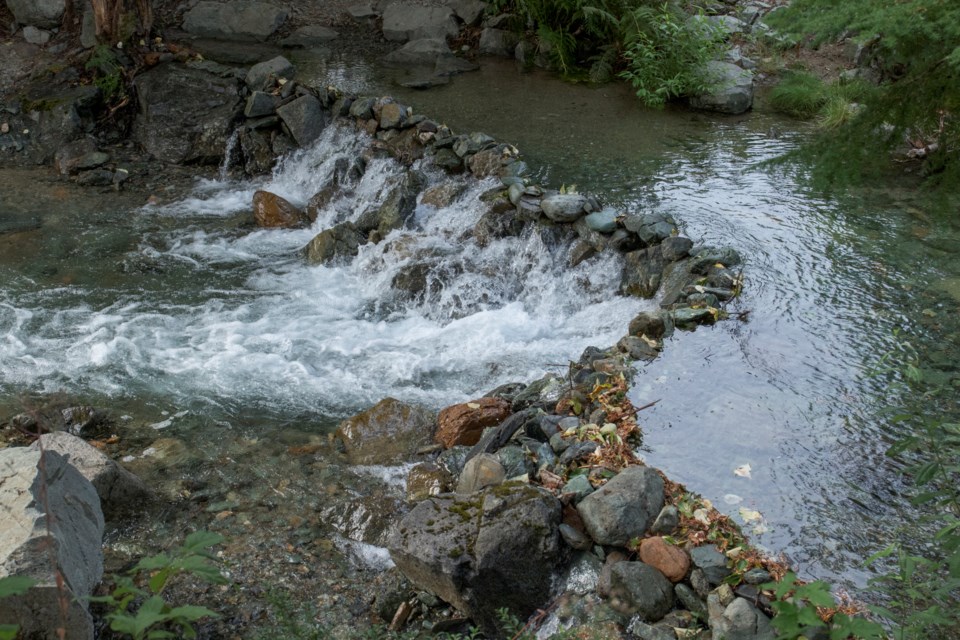An unauthorized dam installed in a section of Whistler’s 19 Mile Creek** is contributing to erosion of the shoreline—but removing the dam requires OK from the province, which could take months to get, according to the Resort Municipality of Whistler (RMOW).
Wildlife photographer Liz Barrett was first tipped off to the DIY rock dam located under a bridge close to 19 Mile Creek by a local landscaper last month, and soon after brought it to the attention of the RMOW’s environmental stewardship team.
“You’re setting a precedent,” said Barrett (who is of no relation to the author of this story). “We all like to make spaces for ourselves and our kids to enjoy the water, but when stuff like this happens, it’s just a slippery slope.”
It’s unclear exactly why the dam was built, although Barrett believes it was created to slow the flow of water so people could safely set up chairs and recreate in the river.
“It is a full-on area,” she added. “No fish will be able to go up that creek. It’s great for kids to paddle, but you can still have your kids paddling without creating a damaged area. There’s no way that should be allowed at all.”
The dam landed on the RMOW’s radar at a time when the municipality is working to manage growing demand for the nearby River of Golden Dreams—which saw between 2015 and ’20—and protect vital fish spawning habitat. According to a report to council this July, the surge in use has led to several environmental concerns, including damaged streambeds, sediment imbalance, and increased turbidity, all of which can be detrimental to native fish populations, particularly during spawning periods.
“It changes the hydrology of the creek, so it’s better not to screw around with nature,” said local ecologist Bob Brett of the dam. “In this case, it’s probably more likely to block tailed frogs from moving up and down the creek instead of fish, but there may be fish that go up that high. It is a clear barrier to any sort of moving. I’d say that dam also runs the risk of failure, which would scour the creek bed if it does break.”
In a statement, the RMOW said it appears the dam was built using riprap—a term denoting the materials used to armour shorelines, streambeds, bridge abutments and other shoreline structures against erosion—from the surrounding area.
“The riprap is there to armour both the bridge and the dike during high flows, and prevent erosion, so we do not want community members to alter this area,” the statement read. “RMOW staff have inspected the dam and have noted that the shoreline is already starting to heavily erode under the bridge.”
Although emails from the environmental stewardship team Barrett shared with Pique seemed to indicate it was the first staff had heard of the rock dam, the municipal statement said the dam was first built in 2020 and washes away each winter. “When this happens, the riprap/erosion protection is being lost downstream,” it continued.
The municipality has plans to add signage in the area, in addition to sharing messaging on its social media channels, to inform the community of the potential impacts of altering the erosion protections in the area.
What’s unclear at this point is if and when the unauthorized dam will be removed. The RMOW did not respond to a question by press time asking whether the dam would be removed, but in the email thread shared with Pique, environmental stewardship manager Heather Beresford wrote to Barrett on Aug. 29 that “if it is to come out, we would have to apply to the province for the proper authorizations, meaning it won’t happen this year.”
Provincial restrictions are strict when it comes to in-stream work, designed to minimize disruption on the ecosystem, especially during spawning season.
“I do accept that you’re not supposed to do in-stream work at certain times of the year, but in a case when someone has already done that in-stream work and blocked a creek, it’s kind of counterintuitive that you can’t just return it to normal,” Brett posited.
**An earlier version of this story incorrectly stated the dam is located on the River of Golden Dreams. It is in fact located on the nearby 19 Mile Creek. Pique regrets the error.




